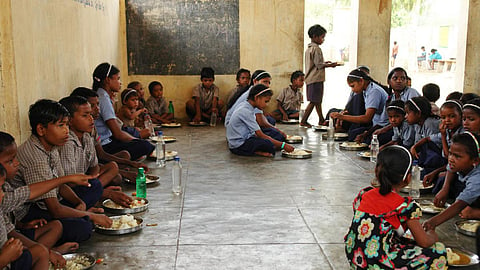
- Topics
- Feature
- Opportunities & Events
- About
- Hindi Portal
- Data
- Topics
- Feature
- Opportunities & Events
- About
- Hindi Portal
- Data

India's food security policy framework includes many proven nutrition interventions. In 2015, India committed to achieving the Sustainable Development Goal (SDG) of zero hunger. As a step towards meeting the targets by 2030, the Government of India launched the Prime Minister's Overarching Scheme for Holistic Nutrition (POSHAN) Abhiyan in 2017. Targets were set to reduce stunting, under-nutrition and low birth weight by 2% each and anaemia by 3% by 2022.
Unfortunately, COVID-19 has increased the risk factors for child malnutrition in India. With the disruption of Anganwadi services and Mid-Day Meal (MDM), a large number of children no longer have access to regular, nutritious meals.
The overburdening of health systems has impaired service delivery of critical health and nutrition interventions for children. Finally, the economic impact of the pandemic has reduced the frequency and quality of meals consumed by households. India has a significant burden of child malnutrition.
It has been predicted that India will fail to meet targets for improvement in nutrition indicators set under POSHAN Abhiyan (earlier National Nutrition Mission) for 2022, and WHO-UNICEF targets for 2030 (Lancet, 2019).
The recently released National Family Health Survey (NFHS)-5, 2019-20 shows that in some of the states the prevalence of malnutrition among children has increased as compared to the previous survey year, 2015-16.
Of the partial data released for 22 states and Union Territories (UT), childhood stunting saw an increase in 13 states, wasting in 12 states and underweight in 16 states (NFHS-5, 2020). While all these data pertain to the period before the pandemic, it can only be expected that the situation is much worse now.
Malnutrition needs to be addressed through a combination of nutrition-specific interventions, which target diet and health, along with nutrition-sensitive interventions which target complementary sectors including social protection, education, and water and sanitation. With increasing recognition of the 'shadow pandemic' of hunger, this is an opportunity for governments to take strong, multi-sectoral measures to improve child nutrition and accord budgetary priority to targeted measures for addressing these gaps.
The attached policy brief highlights the need for increased public provisioning on child health and nutrition and identifies a range of short-term and long-term policy measures to build a resilient nutrition system. The section below discusses the policy measures to deal with the challenges.
Disruption in service delivery of feeding programmes
The allocation for Anganwadi services increased by 3.5% over last year, while the allocation for MDM remained the same. The 15th Finance Commission identified the need for higher spending on nutrition and recommended additional grants of Rs. 7735 crore to States for increased spending under the Special Nutrition Programme (SNP), based on inflation and the need for food fortification.
Policy measures needed
Disruption in health services for children
Several key nutrition-specific interventions for children are delivered through primary health infrastructure and the National Health Mission (NHM). These include immunisation, Iron and Folic Acid (IFA) supplementation, and prevention and treatment of childhood diarrhoea, and tracking and treatment of Severe Acute Malnutrition (SAM).
Policy measures needed
Reduction in food security
The State of Food Security and Nutrition in the World Report 2020 shows that India continues to have the largest population of food-insecure people accounting for 22 per cent of the global burden of food insecurity. In fact, food insecurity in India has increased by 3.8 percentage points between 2014 and 2019 (Bansal, 2020). Plummeting means of income and depleting savings due to COVID-19 will further increase the proportion of food insecure people in India which directly affects children's nutrition.
Policy measures needed
Reduction in dietary quantity
Financial constraints due to the pandemic will impact the dietary intake of poor households as they shift towards cheaper and less nutritious food.
Policy measures needed
Increase in food prices
Accessibility and affordability of food highly depend on the price of the food products. In response to the COVID-19 and subsequent lockdown, while the staple grain prices have remained stable, prices for more nutritious foods like pulses, vegetables, and eggs have risen, making it more difficult for Indian consumers to afford them. Thus, the access to nutrient-rich food which was already skewed has become more inequitable during this pandemic.
Policy measures needed
The marginalised at risk
Children from the marginalised sections of the population including Dalits, Adivasis, Persons with Disabilities, migrants, and homeless are already vulnerable to malnutrition. Girls belonging to marginalised sections, especially adolescent girls, are the worst affected during the pandemic.
Policy measures needed
The policy brief by CBGA and CRY is available here - Impact of COVID-19 on Child Nutrition in India: What are the Budgetary Implications?